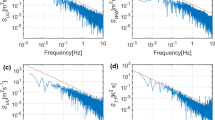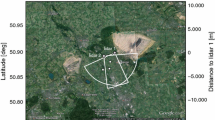Abstract
During the Dynamics and Chemistry of the MarineStratocumulus (DYCOMS) experiment in July–August 1985, the NCAR Electra aircraft flew a series of flight legs just at the top of the marinestratocumulus cloud decks that cap the mixed layer off the coast of southernCalifornia. Because of the corrugated structure of the cloud-top, the aircraft, which was flown at a nearly constant level and adjusted only to maintain its altitude at the average cloud-top height, was alternately within and above the clouds – roughly half the time in each domain. These legs were used to examine the structure of the cloud-top by compositing the segments on either side of the cloud/clear-air interface, which was identified by the transitions of liquid water measured by the Forward Scattering Spectrometer Probe (either increasing or decreasing) through a threshold of 0.04 × 10-3 kg m-3.An equivalent vertical distance (EVD) from the cloud-top was obtained from the horizontal flight legs by estimating the average slope of the cloud-top from the cloud-top radiation temperature. The results show that a near discontinuity occurs in variables across cloud top over an EVD of 0.3 m, but that above this, the air has already been modified by boundary-layer air. Thus, cloud-top is not the limit of mixing of boundary-layer air. This mixing may extend to tens of metres or more. The bulk Richardson number in the vicinity of cloud-top increases from near zero within the cloud to about 1.2 at an EVD of 3–6 m above cloud. Fluctuations of the three velocity components within cloud are nearly equal; above cloud the vertical component structure function is about half the horizontal components. The scalar structure functions are about an order of magnitude higher above cloud than in cloud. The structure parameters of temperature and humidity measured just below cloud-top agree reasonably well with predicted values based on a previously-developed model for the clear convective boundary layer. Above cloud, the scalar structure parameters are much larger, but their interpretation is questionable, since this region does notcontain isotropic turbulence.
Similar content being viewed by others
References
Deardorff, J. W.: 1980, 'Cloud Top Entrainment Instability', J.Atmos.Sci. 37, 131–147.
Gerber, H., Arends, B. G., and Ackerman, A. S.: 1994, 'New Microphysics Sensor for Aircraft Use', Atmos.Res. 31, 235–252.
Kaimal, J. C., Wyngaard, J. C., Haugen, D. A., Cote, O. R., Izumi, Y., Caughey, S. J., and Readings, C. J.: 1976, 'Turbulence Structure in the Convective Boundary Layer', J.Atmos.Sci. 33, 2152-2169.
Kawa, S. R. and Pearson, R. Jr.: 1989, 'An Observational Study of Stratocumulus Entrainment and Thermodynamics', J.Atmos.Sci. 46, 2649–2661.
King, W. D., Parkin, D. A., and Handsworth, R. J.: 1978, 'A Hot Wire Liquid Water Device Having Fully Calculable Response Characteristics', J.Appl.Meteorol. 17, 1809–1813.
rKuo, H. and Schubert, W. H.: 1988, 'stability of Cloud-Topped Boundary Layers', Quart.J.Roy. Meteorol.Soc. 114, 887–916.
Lenschow, D. H., Paluch, I. R., Bandy, A. R., Pearson, R. Jr., Kawa, S. R., Weaver, C. J., Huebert, B. J., Kay, J. G., Thornton, D. C., and Driedger, A. R. III: 1988, 'Dynamics and Chemistry of Marine Stratocumulus (DYCOMS) Experiment', Bull.Amer.Meteorol.Soc. 69, 1058–1067.
Lilly, D. K.: 1968, 'Models of Cloud-Topped Mixed Layers Under a Strong Inversion', Quart.J.Roy. Meteorol.Soc. 94, 292–309.
Moeng, C.-H. et al.: 1996, 'simulation of a Stratocumulus-Topped PBL: Intercomparison among Different Numerical Codes', Bull.Amer.Meteorol.Soc. 77, 261–278.
Nicholls, S.: 1989, 'The Structure of Radiatively Driven Convection in Stratocumulus', Quart.J. Roy.Meteorol.Soc. 115, 487–511.
rNicholls, S. and Turton, J.D.: 1986, 'An Observational Study of the Structure of Stratiform Cloud Sheets: Part II: Entrainment', Quart.J.Roy.Meteorol.Soc. 112, 461–480.
Obukhov, A. M.: 1960, 'structure of Temperature and Velocity Fields under Conditions of Free Convection', Izv.Akad.Nauk.SSSR, Ser.Geofiz. 9, 1392–1396.
Paluch, I. R. and Lenschow, D. H.: 1991, 'stratiform Cloud Formation in the Marine Boundary Layer', J.Atmos.Sci. 48, 2141–2158.
Randall, D. A.: 1980, 'Conditional Instability of the First Kind Upside-Down', J.Atmos.Sci. 37, 125–130.
Randall, D. A., Coakley, J. A. Jr., Fairall, C.W., Kropfli, R. A., and Lenschow, D. H.: 1984, 'Outlook for Research on Subtropical Marine Stratiform Clouds', Bull.Amer.Meteorol.Soc. 65, 1290–1301.
Sayler, B. J. and Breidenthal, R. E.: 1998, 'Laboratory Simulations of Radiatively Induced Entrainment in Stratiform Clouds', J.Geophys.Res. 103, 8827–8837.
Schwiesow, R. L., Glover, V. M., and Lenschow, D. H.: 1988, 'Measurements with Airborne Lidar: An Example from FIRE and Potential Applications to Turbulence and Diffusion', in Preprint Volume, Eighth Symposium on Turbulence and Diffusion of the American Meteorological Society, 26–29 April 1988, San Diego, CA., pp. 197–200.
Siems, S. T., Bretherton, C. S., Baker, M. B. Shy, S., and Breidenthal, R. E.: 1990, 'Buoyancy Reversal and Cloud-Top Entrainment Instability', Quart.J.Roy.Meteorol.Soc. 116, 705–739.
Tatarskii, V. I.: 1971, The Effects of the Turbulent Atmosphere on Wave Propagation, Kefer Press, Jerusalem, 472 pp. [NTIS TT 68-50464].
Wyngaard, J. C. and LeMone, M. A.: 1980, a'Behavior of the Refractive Index Structure Parameter in the Entraining Convective Boundary Layer', J.Atmos.Sci. 37, 1573–1585.
Author information
Authors and Affiliations
Rights and permissions
About this article
Cite this article
Lenschow, D.H., Zhou, M., Zeng, X. et al. Measurements Of Fine-Scale Structure At The Top Of Marine Stratocumulus. Boundary-Layer Meteorology 97, 331–357 (2000). https://doi.org/10.1023/A:1002780019748
Issue Date:
DOI: https://doi.org/10.1023/A:1002780019748




